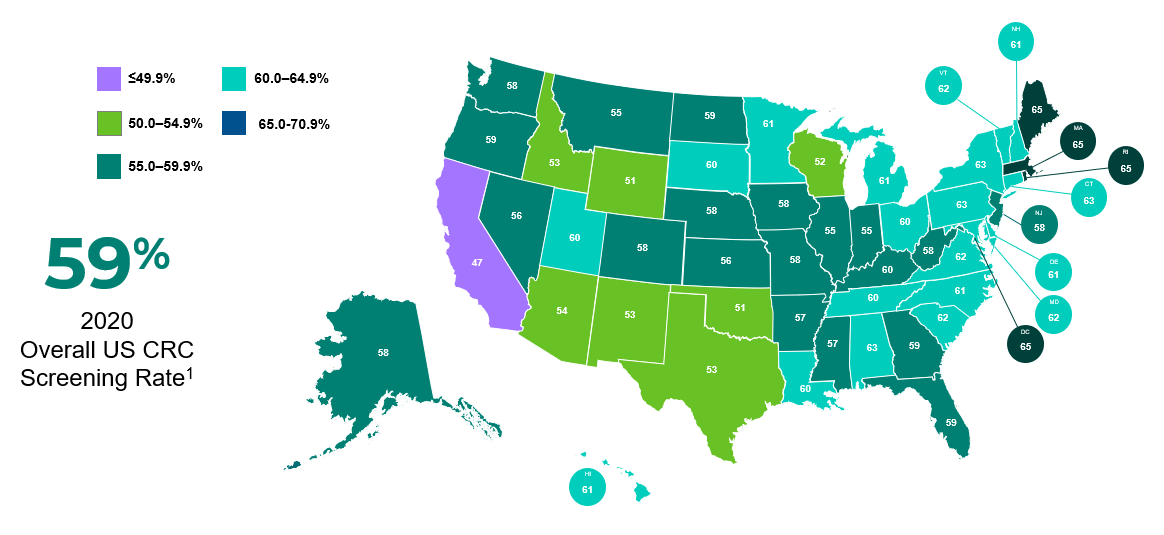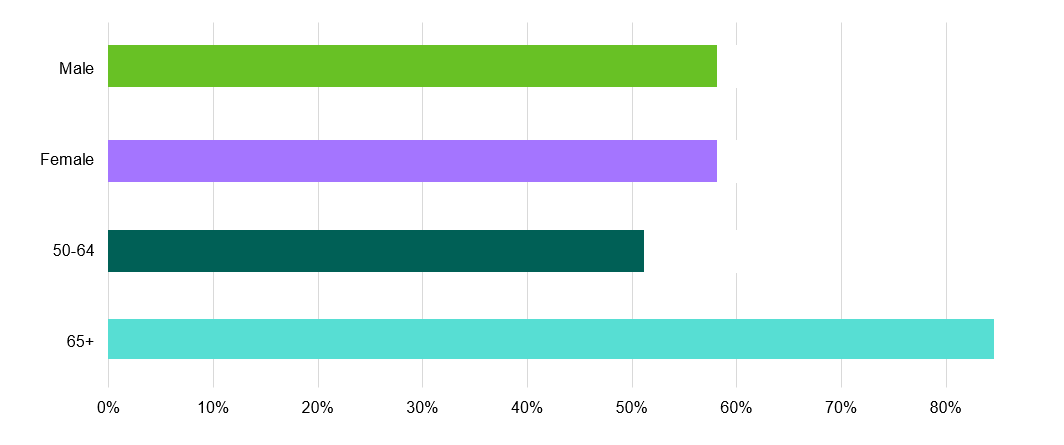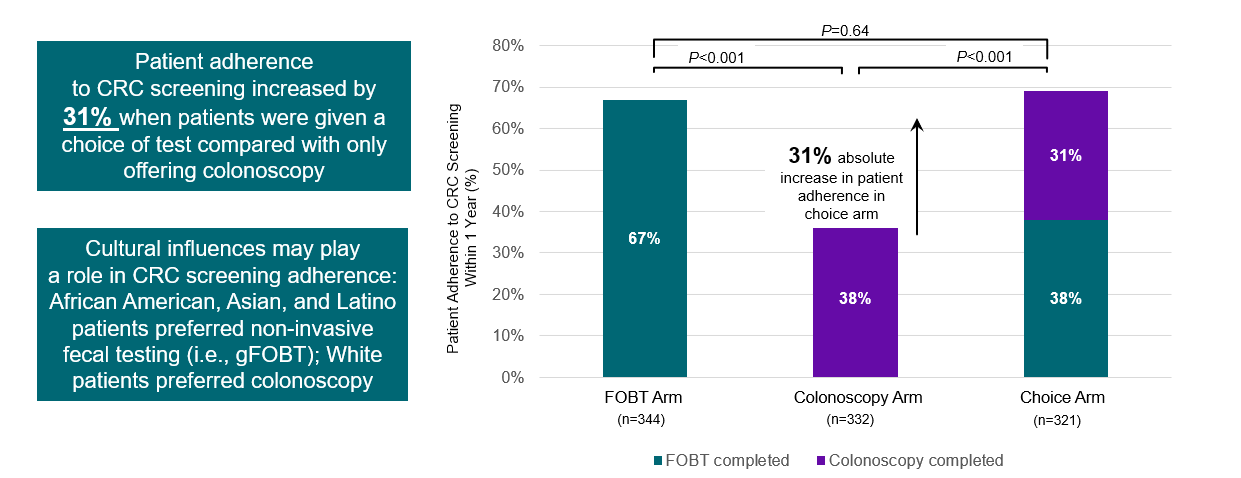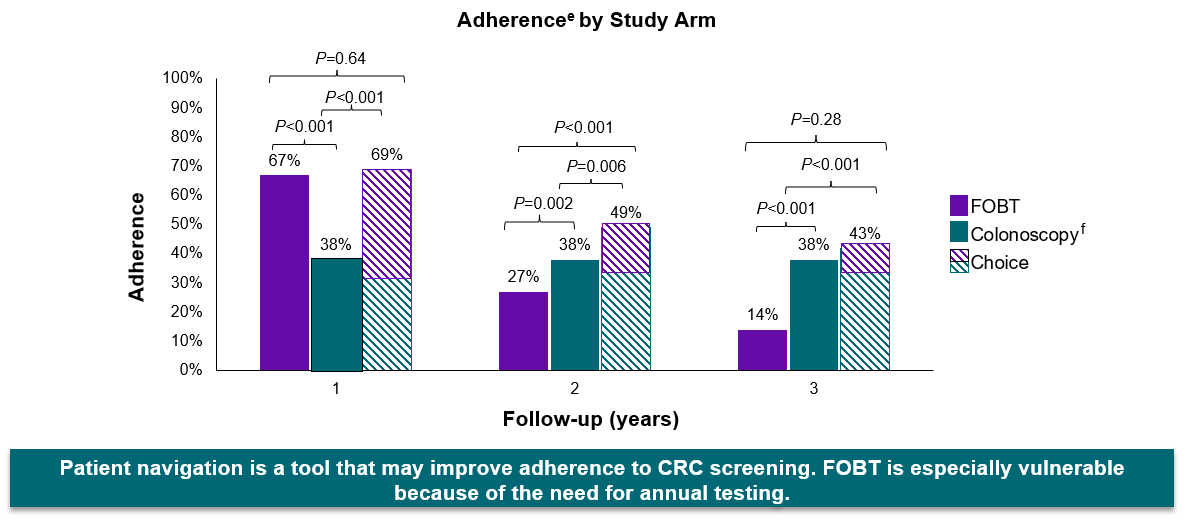The percentage of adults aged 45 to 75 years who were up-to-date with colorectal cancer (CRC) screening in 2021 was 59%; however, screening rates in the US remain below the nationwide target of 80% regardless of state, age, or ethnicity.1,2a According to the National Health Interview Survey conducted in 2021, screening rates for CRC (59%) continued to lag those for cervical cancer (81.1%) and breast cancer (72.8%).1 Major organizations also support shared decision-making related to choice of screening modalities,3,4 as evidence has shown that this strategy may improve screening rates.5,6
ADULTS AGED 45–75 YEARS WHO REPORT BEING UP-TO-DATEb WITH CRC SCREENING, BY STATE (2020)1

Number of Age-eligible Adults Who Reported Receipt of Screening in the Past Year in 2019 and 2021 in the United States7

COLORECTAL CANCER SCREENING RATES BY AGE/GENDER1

OFFERING PATIENTS A CHOICE OF SCREENING METHOD MAY IMPROVE SCREENING RATES6,c

ADHERENCE TO ASSIGNED CRC SCREENING STRATEGY OVER 3 YEARS5,d

- In a 3-year follow-up (to the study in the preceding panel6) comparing completion of CRC screening strategies, participants offered a choice between FOBT and colonoscopy continued to have relatively high adherence, whereas adherence in the FOBT group fell significantly below that of the choice and colonoscopy groups5
- Participants assigned to annual FOBT completed screening at a significantly lower rate over 3 years (14%) than those assigned to colonoscopy (38%, P<0.001) or choice (42%, P<0.001)5
References
1 American Cancer Society. Colorectal Cancer Facts & Figures 2023-2025. Atlanta: American Cancer Society; 2023.
2 NCCRT. 80% in every community. Accessed June 21, 2023. http://nccrt.org/
3 Wolf AMD, Fontham ETH, Church TR, et al. Colorectal cancer screening for average-risk adults: 2018 guideline update from the American Cancer Society. CA Cancer J Clin. 2018;68(4):250-281
4 Shaukat A, Kahi CJ, Burke CA, et al. ACG clinical guidelines: Colorectal cancer screening 2021. Am J Gastroenterol. 2021;116:458-479.
5 Liang PS, Wheat CL, Abhat A, et al. Adherence to competing strategies for colorectal cancer screening over 3 years. Am J Gastroenterol. 2016;111(1):105-114
6 Inadomi JM, Vijan S, Janz NK, et al. Adherence to colorectal cancer screening: a randomized clinical trial of competing strategies. Arch Intern Med. 2012;172(7):575-582.
7 Star J, Bandi P, Siegel RL, et al. Cancer screening in the United States during the second year of the COVID-19 pandemic. J Clin Oncol. 2023;JCO2202170a The NCCRT has established the goal of 80% of adults ages ≥50 being regularly screened for CRC.
b Up to date: Home-based blood stool test within the past year, OR blood stool test within the past 3 years with sigmoidoscopy within the past 5 years OR colonoscopy within the past 10 years.
c This randomized clinical trial of competing CRC screening strategies in a racially/ethnically diverse population was conducted between April 2007 and March 2010 in the San Francisco Community Health Network. N=997, Age=50-75 with average risk for CRC.
d Cluster randomized trial conducted in San Francisco Health Network, a safety net public health system, that evaluated adherence to assigned strategy over 3 years in patients at average risk for CRC aged 50–79 (n=997): annual FOBT (n=344), colonoscopy (n=332), or choice between annual FOBT and colonoscopy (n=321)
e Adherence to screening was defined as completion of 3 FOBT cards in each of 3 years after enrollment or completion of colonoscopy within the first year after enrollment.
f Adherence to colonoscopy was 38% after 1 year and, by definition, remained constant for all 3 years.
Last Updated: 06/21/2023